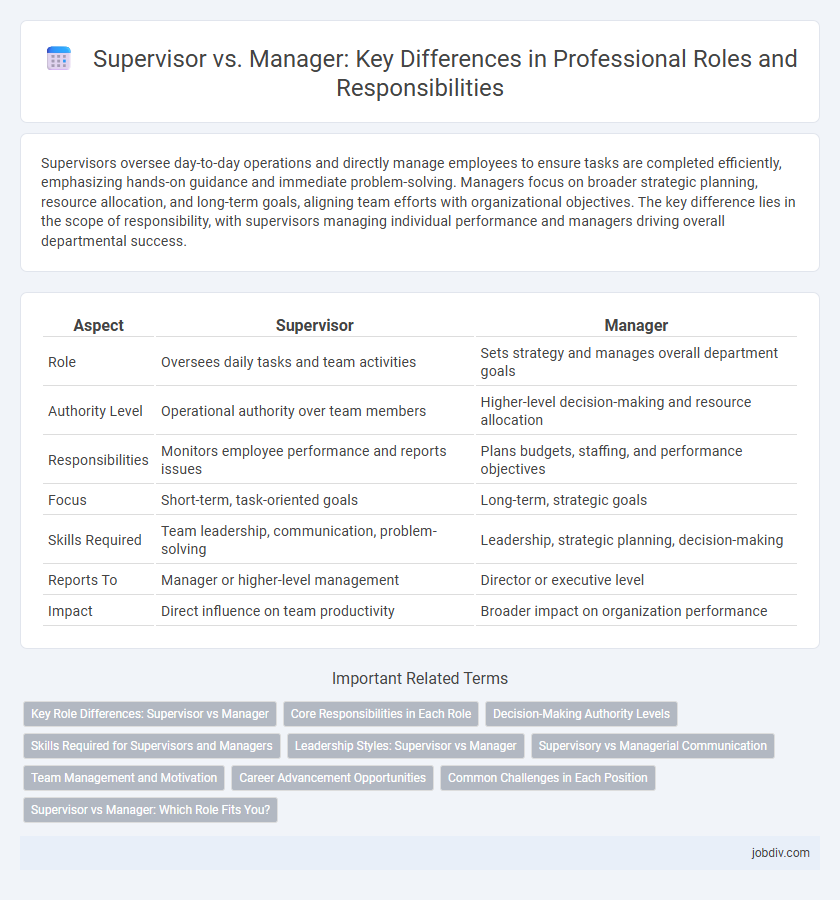Supervisors oversee day-to-day operations and directly manage employees to ensure tasks are completed efficiently, emphasizing hands-on guidance and immediate problem-solving. Managers focus on broader strategic planning, resource allocation, and long-term goals, aligning team efforts with organizational objectives. The key difference lies in the scope of responsibility, with supervisors managing individual performance and managers driving overall departmental success.
Table of Comparison
| Aspect | Supervisor | Manager |
|---|---|---|
| Role | Oversees daily tasks and team activities | Sets strategy and manages overall department goals |
| Authority Level | Operational authority over team members | Higher-level decision-making and resource allocation |
| Responsibilities | Monitors employee performance and reports issues | Plans budgets, staffing, and performance objectives |
| Focus | Short-term, task-oriented goals | Long-term, strategic goals |
| Skills Required | Team leadership, communication, problem-solving | Leadership, strategic planning, decision-making |
| Reports To | Manager or higher-level management | Director or executive level |
| Impact | Direct influence on team productivity | Broader impact on organization performance |
Key Role Differences: Supervisor vs Manager
Supervisors primarily oversee the day-to-day activities of frontline employees, ensuring task completion and addressing immediate issues on the ground. Managers focus on strategic planning, resource allocation, and long-term goal achievement within a department or organization. The key role difference lies in supervisors managing operational execution while managers drive organizational direction and decision-making.
Core Responsibilities in Each Role
Supervisors primarily oversee daily team operations, ensuring tasks are completed efficiently while directly managing employee performance and providing immediate support. Managers focus on strategic planning, resource allocation, and long-term goal setting to align team efforts with organizational objectives. Both roles require strong leadership, but supervisors emphasize hands-on guidance whereas managers drive broader business outcomes.
Decision-Making Authority Levels
Supervisors typically have limited decision-making authority, focusing on day-to-day operational decisions and directly overseeing employee tasks. Managers hold broader decision-making power, including strategic planning, resource allocation, and policy implementation across departments. The distinction in authority levels impacts the scope and impact of decisions within organizational hierarchies.
Skills Required for Supervisors and Managers
Supervisors require strong interpersonal skills, conflict resolution abilities, and hands-on technical expertise to effectively guide team members and ensure task completion. Managers need advanced strategic thinking, financial acumen, and leadership capabilities to oversee departments, align goals with organizational objectives, and drive business growth. Both roles demand effective communication and decision-making skills, but managers prioritize long-term planning while supervisors focus on day-to-day operations.
Leadership Styles: Supervisor vs Manager
Supervisors typically adopt a more hands-on leadership style, emphasizing direct oversight and day-to-day guidance of their team members. Managers focus on strategic leadership, setting long-term goals and aligning team efforts with organizational objectives. Effective leadership requires adapting styles to balance operational demands with motivational and developmental support.
Supervisory vs Managerial Communication
Supervisory communication centers on direct, task-oriented interactions focused on guiding team members and monitoring performance to ensure operational goals are met efficiently. Managerial communication incorporates strategic, multi-level dialogue involving planning, decision-making, and motivating cross-functional teams to align with organizational objectives. Effective supervisory communication emphasizes clarity and immediate feedback, while managerial communication requires broader influence and delegation skills to drive long-term success.
Team Management and Motivation
Supervisors directly oversee frontline employees, ensuring daily tasks are completed efficiently while fostering immediate team motivation through hands-on support and clear communication. Managers focus on strategic team management, setting long-term goals, allocating resources, and driving performance by aligning individual motivations with organizational objectives. Effective team leadership requires supervisors to handle operational challenges and managers to develop motivational frameworks that enhance productivity and employee engagement.
Career Advancement Opportunities
Supervisors often oversee day-to-day team operations and provide direct guidance, positioning them as entry-level leaders with opportunities to develop foundational management skills. Managers typically hold broader responsibilities, including strategic planning, resource allocation, and performance evaluation, which open pathways to higher executive roles. Advancing from supervisor to manager enhances career prospects by expanding leadership capabilities and increasing organizational influence.
Common Challenges in Each Position
Supervisors often face challenges related to direct team oversight, including balancing workload distribution and maintaining consistent performance while fostering motivation. Managers typically confront broader strategic issues such as aligning departmental goals with organizational objectives and managing cross-functional communication. Both roles require strong leadership skills, but supervisors emphasize operational efficiency, whereas managers focus on long-term planning and resource allocation.
Supervisor vs Manager: Which Role Fits You?
Supervisors focus on overseeing daily team operations and ensuring task completion, while managers take on broader responsibilities such as strategic planning, resource allocation, and performance evaluation. Choosing between a supervisor and manager role depends on your preference for hands-on leadership or strategic oversight within an organization. Assessing your skills in team coordination versus decision-making and long-term planning helps determine which position aligns with your career goals.
Supervisor vs Manager Infographic

 jobdiv.com
jobdiv.com